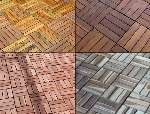Composite Decking: 7 Fundamentals for Ideal Backyard Space
Composite decking, as a manufactured product, is gaining great popularity these days, mostly because of its eco-friendliness and low maintenance.

The ingredients of such lumber - wood fiber, plastic, binding agent, and other additives - provide denser, stronger, and heavier material than wood alone.
As a result, this smart combination creates a product that looks like real wood, but bears the toughest of conditions.
In addition to incredible versatility, composite decking ranges a vast variety of grains and colors to mimic all possible species of wood.
As well, the boards are available in standard lengths but different widths, which help to choose the preferable look.
More so, a composite decking material will neither wear and fade nor rot and warp with time.
Also, there is no need to worry about splinters and fire.
As for the cost effectiveness, you will save much over the years on sanding back, staining or re-oiling of this timber every year.
In a word, what else could you ask for?
Composite Decking: 7 Essentials You Need to Know
- Composites began emerging in the 1990s, as the alternative material for deck construction.
- There is a combination of processed wood and plastic, which gives the natural appearance. In fact, all the components are mixed, and then this mixture is heated. After that, board-shaped lengths are formed and cooled.
- Composite lumber has many obvious benefits. Firstly, it's less likely to delaminate or split. Secondly, it is of lighter weight and, thus, of easier handling. Thirdly, it is scratch, stain, and mold resistant, having a longer life. Fourthly, it comes as a finished product and needs no staining, sanding, or painting.
- Speaking of disadvantages, composite materials are more costly in comparison with normal or treated lumber. However, composites last longer, being simply the higher initial investment.
- There are only 2 types of composite decking on the market: solid and hollow. The 1st is heavier and looks more like wood. Due to its greater mass, such decking will contract and expand with temperature fluctuations. The 2nd type has a man-made look and won't expand/contract as much as a solid one. But this is more prone to damage before installation. In general, solid composite decking is preferable because of its resemblance to real wood and superior strength.
- As for the types of composite decking materials, there are polyethylene-based (1), polypropylene-based (2), and non-wood (3) plastics. The industry tends to move away from the polyethylene-based composites and focus on the polypropylene-based or PVC-based products, because of no staining or no water absorbing.
- Composite deck installation costs are comparable. Though the foundation for wood and composite decks is the same, the procedures of gapping and supporting differ. Typically, the manufacturers guide the size of gaps and the number of fasteners. Actually, the type of composite decking dictates certain parts of the installation.
Well, your ideal deck design may be created with the help of premium products like composite decking too, if you are looking for an attractive, low maintenance finish, and other advantages.
Ξ Related Post from "Composite Decking"
Comments


